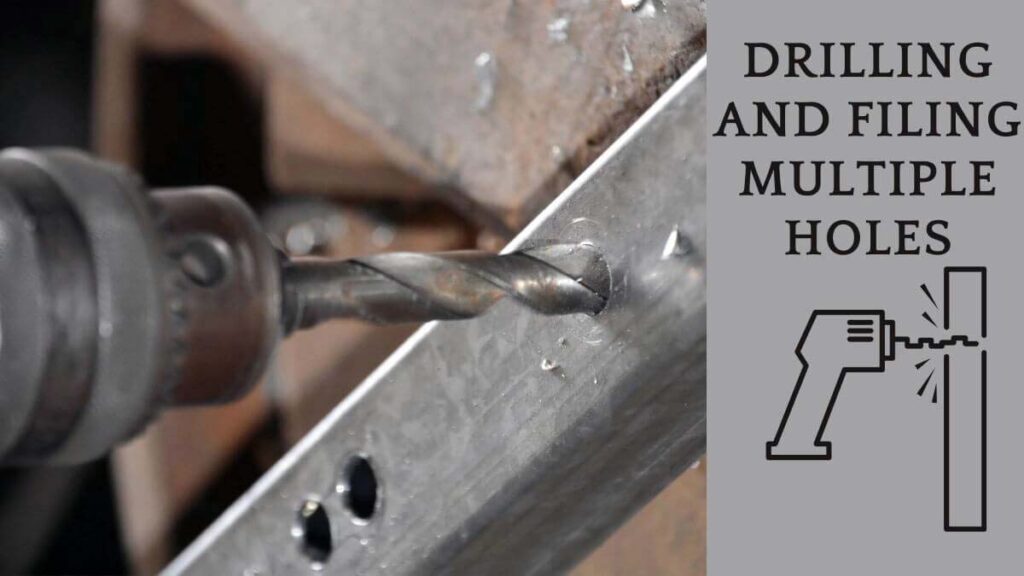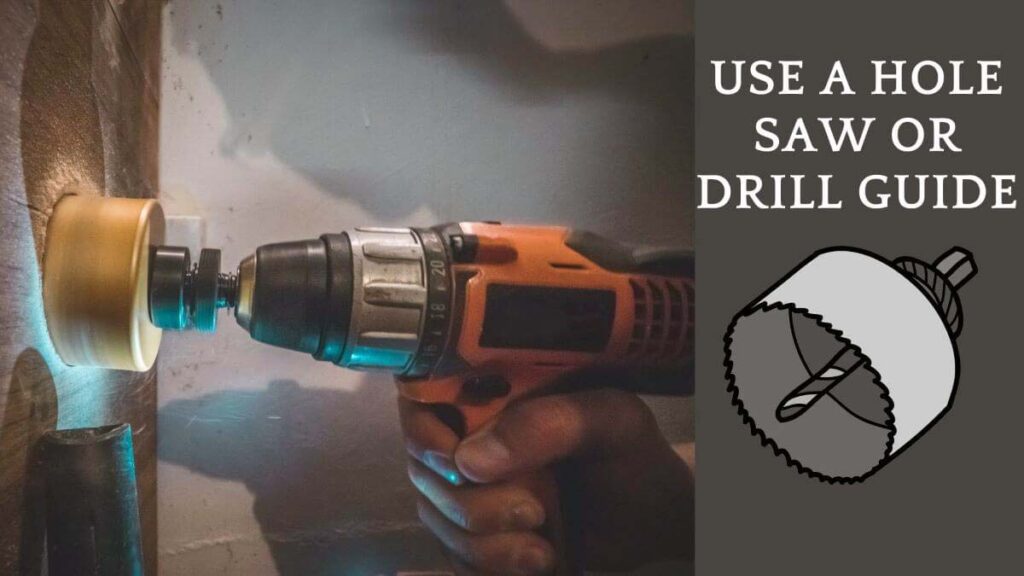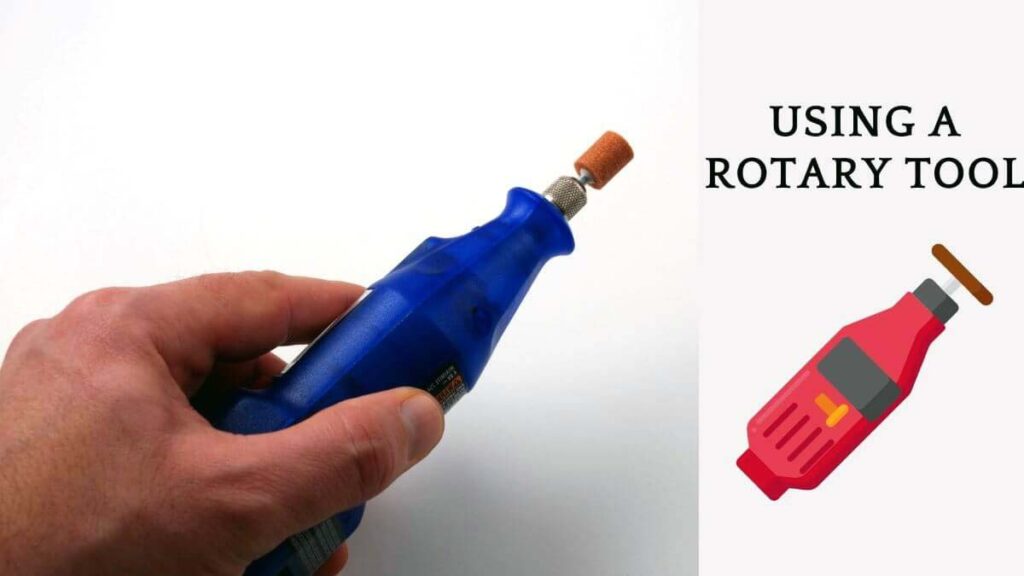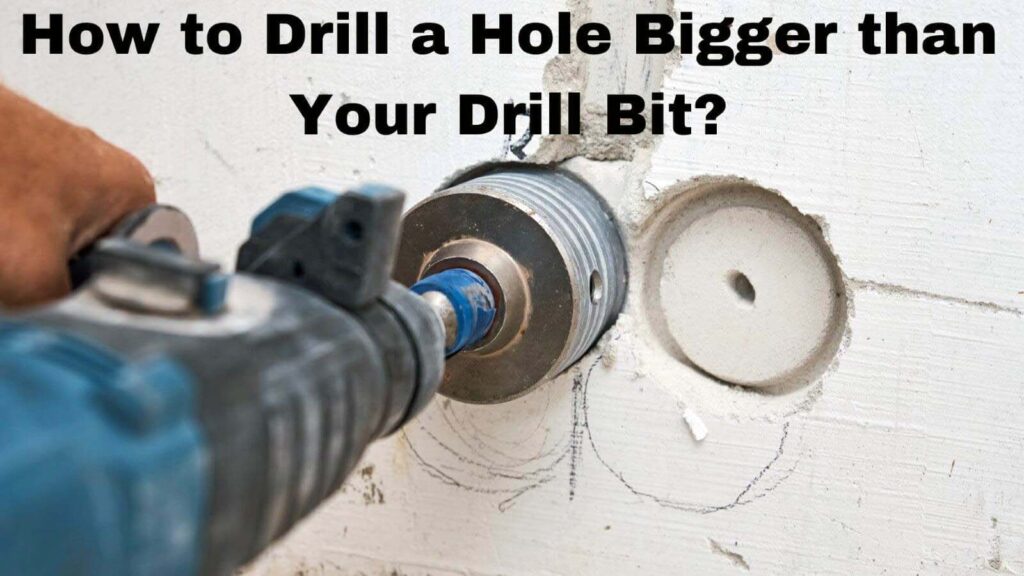Have you ever needed to drill a hole larger than your drill bit? For example, getting the right-sized piece could mean wasting time. Or you may not have enough money to buy new drill bits.
Whatever the reason, drilling a larger hole than your drill bit can be useful. When I first started DYing, I frequently found myself without the proper size drill bit. I’ve learned a few ways to assist you to drill a hole larger than your drill bit.
Apply a modest amount of pressure to your drill bit as you slide it in and out of the hole to create a slightly larger hole than your drill bit’s diameter will allow.
Additionally, you can use sandpaper wrapped around a circular wooden rod that is somewhat thinner than your drill bit. The sandpaper will enlarge the hole created by the drill bit. However, the outcome will be seamless.
Drill the whole area covered by the guide using a drill guide with a larger hole than your drill bit.
Drill a large hole with a little drill bit by drawing a circle and drilling around it. Now, using a file, remove the circular portion. Following that, use a tapered reamer to enlarge a drilled hole.
There is no single method for drilling a hole larger than the diameter of your drill bit. Each case is unique, depending on the nature of the hole to be dug and the tools available.
As we are attempting to drill a hole larger than our drill bit without investing in new gear, there are a variety of techniques to get a larger hole with the instruments already in your toolbox.
In this situation, you must drill in a specific manner. In this guide, we’ll show you how to drill a hole bigger than your drill bit without causing damage to the hole’s surrounding surface.
Table of Contents
Steps of Drill a Hole Bigger than Your Drill Bit
By spinning, a drill bit creates a well-shaped hole. To drill an accurate hole, the drill bit must rotate uniformly, which requires that the drill bit’s centre register in the proper location.
When you create a hole that is larger than the drill bit, the bit becomes disoriented inside the hole. When drilling a large hole with a smaller drill bit, there is a danger that the holes will become clogged.
As a result, you must use caution. It is preferable to acquire a large drill bit in order to create a larger hole. However, if you do not have one, you should follow the steps below:
●Step 1: To begin, drill a small hole by squeezing the drill’s trigger. After drilling a hole, and while the drill bit is still spinning, carefully work your way around the hole in a circular motion to enlarge it. Continue moving the drill until the desired size is achieved.
Another method for drilling larger holes is to use a guide. Make a hole in a piece of hardwood using the guide. You can now insert the drill bit through the desired hole size and begin drilling. The drill guide assists in maintaining the bit’s position within the hole and prevents it from spinning out.
The guide’s edges are extremely firm, ensuring that the bit will not stray. This approach can also be used to enlarge a hole.
●Step 2: Next, a tapered reamer can be used. To begin, drill a hole with the drill bit you have and then use a reamer to expand the hole in the wood, plastic, or metal.
Simply insert the reamer into the hole and begin twisting to enlarge it. The reamer should be constantly twisted until the appropriate hole size is obtained. Utilizing a reamer may not result in a clean hole. The sides will be crooked.
●Step 3: A pilot bit can be used to create larger holes for a new handle or knob. When a hole already exists, it becomes difficult to enlarge or create a larger hole than the existing one, as there is no wood to bite into.
In this case, a thin piece of luan or plywood might be added to either side of the work area. Securely clamp the components together and begin drilling. The scrap pieces will stabilize the pilot bit while it cuts the workpiece; as a result, the workpiece’s surface will not be marred or damaged.
●Step 4: Finally, you can use step drill bits to create a large hole. They are quite capable and adequate for specific purposes. Thus, using the methods outlined above, you can create a large hole using a smaller drill bit.
Read More: How to Drill a Hole in Plastic without a Drill
Tips and Safety Precautions
- Always prioritize safety by wearing the appropriate protective gear, including safety glasses and hearing protection.
- Use the correct bit for the job. Step drill bits and hole saws are designed for enlarging holes and will produce cleaner results than trying to force a standard bit to do the job.
- Take your time and apply steady, even pressure when drilling. Rushing can lead to mistakes and accidents.
- Keep your work area clean and free of debris to prevent tripping hazards and maintain a clear view of your work.
- If you’re drilling a large hole in metal, consider using cutting oil or a lubricant to reduce friction and extend the life of your drill bit.
7 Best Methods for Drilling a Hole Larger Than Your Drill Bit
Now that we’ve shown that it is possible to drill a hole larger than the diameter of your largest drill bit, let’s consider how to accomplish this feat, and yes, there are multiple viable options.
1. Waggle the Drill
To make a hole slightly larger than your existing drill bit, simply drill a hole and then carefully move the drill bit from side to side or swirl it in a circular motion to enlarge it.
In other words, after drilling through the material, move the drill bit in a circular motion until the hole is large enough for your purposes. This method is perfect if you require a hole slightly larger than your drill bit and are working with soft material.
2. Drilling and Filing Multiple Holes

If the hole that you need to drill is significantly larger than your largest drill bit, you can attempt drilling out the perimeter of the hole with a narrow drill bit. In other words, you want to create a circle on the surface where the hole will be located.
Drill holes along the circle’s outer perimeter with a tiny drill bit. Once sufficient holes have been drilled around the perimeter, the interior material should simply fall out, leaving a big hole. Naturally, this will not be very smooth or even, and you will use either a file or some sandpaper to smooth it out and create a perfect circle.
3. Use a Hole Saw or Drill Guide

A drill guide is a specialized attachment that attaches to the front of a drill and drill bit. It enables you to drill holes larger than the diameter of the bit. In reality, and for the purposes of this essay, a drill guide is essentially synonymous with a hole saw (there are differences, but for the purpose of drilling a large hole, both will do just fine).
All you need is a drill guide or hole saw of a suitable size. Mark the circle’s centre point and then align the drill guide’s or hole saw’s centre with it, such that the guide’s or hole saw’s circumference fits the circumference of the hole you wish to drill. Once everything is aligned, simply drill the hole.
4. Use a Sandpaper & Wooden Dowel
The hole cannot be drilled any larger than the largest drill bit, but you may easily enlarge an existing hole using this method. Sandpaper-wrapped dowel that is just slightly smaller than the current hole will suffice here.
Use just enough sandpaper so that the sandpaper-coated dowel can still fit into the hole. There are various methods, but the easiest is to insert the dowel into your drill and utilize it in the same manner as a rotary tool. Sanding away the inside of the hole is all you’re doing here, so long as it’s big enough for what you’re doing.
5. Using a Rotary Tool

If you have a rotary tool on hand, you can always attach a sanding head to it and then sand the interior of the hole until it is large enough for whatever reason you require. Although this does not constitute drilling a hole larger than the diameter of your largest drill bit, it is a very simple and quick method of enlarging an existing hole.
6. Make Use of a Round Hand File
If you have a rod file or rounded hand file on hand, all you need to do is put the file into the existing hole and file away material until the hole is large enough for your purposes. When everything is said and done, this may be one of the quickest, cheapest, and easiest ways to create a hole larger than the diameter of your largest drill bit.
7. Use a Reamer with a Tapered End
If you have a tapered reamer on hand, this is another excellent tool for enlarging an existing hole. All you need to do is select the suitable size reamer that will fit into the hole while still being large enough to accommodate your demands (you may need several reamers to achieve the proper size).] Simply insert the reamer into the hole and twist from top to bottom until the hole is large enough.
Read More: How to Remove a Stuck Drill Bit from Wood
Tips for Successful Drilling
1. Secure the Material
Ensure the material you’re drilling into is securely clamped or stabilized. This prevents movement during drilling and ensures accuracy.
2. Lubrication
Using lubrication can reduce friction and heat buildup during drilling. Apply a lubricant appropriate for the material you’re working with.
3. Go Slow and Steady
Drill at a slow speed and apply even pressure. This prevents overheating and allows for better control.
4. Check Bit Sharpness
Using a sharp drill bit is essential for clean and efficient drilling. Replace the bit if it’s dull or worn.
5. Safety Gear
Always wear appropriate safety gear, including safety goggles and gloves, to protect yourself from debris and potential hazards.
How to Increase the Size of an Existing Hole in Metal?
Large holes in a metal require a larger drill bit. So, a reamer is a solution. The tool can only enlarge an existing hole.
If you don’t have a larger drill bit, drill the metal with the present drill bit then reamer it. Here’s how you use a reamer to make a huge hole.
1. Secure the workpiece to keep it stable when drilling.
2. Next, drill a larger hole in the metal with a reamer.
3. Next, get a reamer that fits the desired hole size.
4. Increase the hole in moderate increments, not all at once.
5. Next, attach the reamer to the drive tool.
6. Insert the reamer into the hole and begin cutting.
7. The reamer’s widest point completes the cut.
8. Remove the reamer after cutting.
Why is the drilled hole bigger than the drill size?
The material being drilled is the most common cause of a larger drilled hole than the drill size. Compared to durable materials, materials that wear out quickly tend to have larger-sized holes. Avoid this problem by using a smaller drill bit than is required.
Tips and Tricks & Don’t Mistakes to Avoid
Before we say good-bye, here are a few final tips:
- If you frequently need to drill large holes, you are better off simply purchasing a larger drill bit.
- If you frequently need to drill really large holes, your best bet is to invest in a hole saw.
- Naturally, if you operate with wooden power equipment, it is critical to wear suitable eye protection to prevent sawdust and small pieces of wood from flying into your eyes.
FAQ
Can I use a regular drill bit to enlarge a hole?
While possible, it’s not the most effective method. Specialized tools like spade bits or hole saws are better suited for enlarging holes.
What materials can I use the step drilling technique on?
The step drilling technique works well on materials like wood, plastic, and thin metals.
How do I prevent chipping or splintering while enlarging a hole?
To prevent chipping, start by drilling a small pilot hole and gradually increase the bit size. Use a backer board to minimize splintering.
Can I use a rotary tool to enlarge a hole in metal?
Yes, a rotary tool with appropriate attachments can be used to enlarge holes in metal.
Conclusion
To get the results you want, you’ll need the correct equipment. Making a hole larger than the drill bit might be tricky, but there are ways to do it safely without damaging the workpiece.
You are free to use whichever way is most convenient for you. In the future, if you need to fix or replace something, you can use the information in this article to make a hole larger than the drill bit. So, Keep in touch with us.

Hey, I am Shihab Uddin, I’m a huge fan of DIY crafts. My workshop is where I spend most of my spare time, and I’m always working on some project. To that end, I’d like to share some of my knowledge and experience with you in power tools, woodworking, and other specialized materials fabrication.
I will guide you with genuine knowledge that can assist you with deciding whether a drill is appropriate according to your requirements or not. If you want to find the best drill and know which type of drill is most suited for your needs, then I can guide you with my expertise. My passion lies in helping others find the correct products they need at an affordable price.


